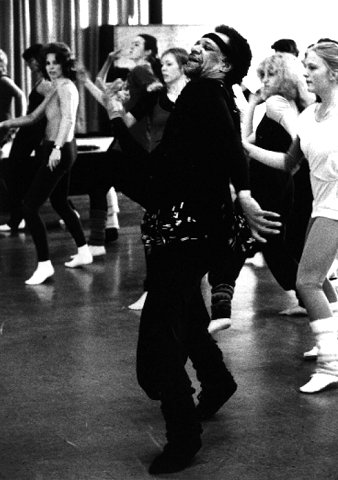Homepage of Nat Horne - Master of Jazz Dance
THE HORNE TECHNIQUE part I
The two major influences in the evolution of Nat's approach to Jazz Dance were Broadway choreographers and performers Jack Cole and Matt Mattox. It was through working with Jack Cole, during the Broadway show JAMAICA, that Nat first glimpsed the enormous possibilities inherent in jazz dancing. From this "exhilarating and powerful" learning experience Nat began to believe what is now his firm conviction that Jazz Dance is a distinct art form, and "while a free form style it ought to contain the discipline of ballet, the control of modern, the rhythm of tap, and the emotion and involvement of ethnic forms of dance."
Later Nat studied for several years with Matt Mattox, a former long-time student of Jack Cole's. These classes of "extraordinary challange and discipline" taught Nat a knowledge and appreciation for a detailed anatomical approach to Jazz Dance. Nat in his instruction extensively uses "isolations" which are exercises in which the various body parts (head, arms, hands, shoulders, rib cage, hips, legs, feet, etc.) are each moved separately from the rest of the body and in all the various ways they might be danced (i.e. the head - back and forth, circular, sideways, diagonally, figure-eight, necking forward, and shimming). This method increases the performer's awareness and control of his body as well as improves muscle tone and flexibility. By "learning to dance the parts of the body you learn to dance the whole."
One of the most important ways the Horne Technique differs from other jazz instruction is the very strong emphasis Nat places on integrating emotion and movement from the onset of training throughout its entirety. Nat believes that "jazz dancing without feeling is merely exercise", and conversely all exercises that the Horne Technique uses are danced - with feeling. Nat wants the student's work to emanate deep with himself. By connecting feeling with movement in all levels of training the awareness and control of the body are heightened, and the body's natural relationship to one's emotional responses to music is made more accessible.
In much the same way, Nat puts a great emphasis on the integration of rhythm with movement and emotion at all times during his classes. Just as Nat's classes are in constant movement, that movement is constantly rhythmic. Even if music is not playing Nat talks his students through exercises making rhythmic use of his voice. Isolations are performed with feeling and in rhythm and are to be experienced as fully and deeply as possible. Nat believes "all things have a rhythm" and seeks to aid the performer "to find the rhythms within himself" and enhance the awareness of the body's natural responsiveness to the rhythms in music.
The Horne Technique follows the dictum: Jazz Dance is emotion expressed through rhythmic movement. To Nat, jazz dancing without feeling or sense of rhythm is "to go through the motions" - the antithesis of what the Horne Technique intends.
